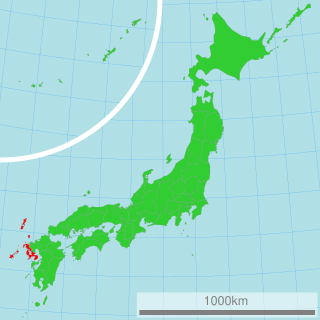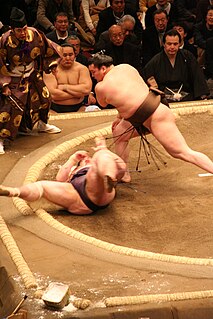
Hokutōriki Hideki is a former sumo wrestler, from Tochigi, Japan. He reached the top makuuchi division in 2002 and was runner-up in three tournaments. He had four special prizes in his career and a gold star for defeating yokozuna. The highest rank he reached was sekiwake. He retired in May 2011 and is an elder of the Japan Sumo Association and a coach at Hakkaku stable.

Miyabiyama Tetsushi is a former sumo wrestler from Mito, Ibaraki, Japan. A former amateur champion, he turned professional in 1998. With the exception of two tournaments, he was ranked in the top division of professional sumo from 1999 until the end of his career in 2013, holding the second highest rank of ōzeki from 2000 to 2001. He won eight special prizes and was runner-up in four top division tournaments. He wrestled for Fujishima stable, where he worked as a coach until opening his own Futagoyama stable.

Terao Tsunefumi is a Japanese former sumo wrestler. He was born in Tokyo, but brought up in Kajiki, Aira District, Kagoshima, Japan. He fought out of Izutsu stable. The highest rank he reached was sekiwake. Despite his relatively light weight he had an extremely long career, spanning 23 years from 1979 until 2002, and was known as the "iron man" of sumo. He is now the head coach of Shikoroyama stable.
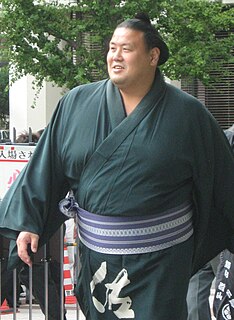
Tosanoumi Toshio, is a former sumo wrestler. He first reached the top division of professional sumo in 1995, winning 13 special prizes and earning 11 kinboshi or gold stars for defeating yokozuna over his long career. The highest rank he reached was sekiwake. He retired in 2010 to become a coach at his stable, Isenoumi stable under the name of Tatekawa.

Toyonoshima Daiki is a professional sumo wrestler from Sukumo, Kōchi, Japan. He made his professional debut in January 2002, reaching the top makuuchi division in September 2004. He has been a runner-up in five tournaments, and has earned ten special prizes. His highest rank has been sekiwake, which he first reached in September 2008 and has held for five tournaments to date. Following a suspension in July 2010 he was demoted to the jūryō division, but upon his return to makuuchi in November 2010 he took part in a playoff for the championship. He has been runner-up in four other top division tournaments. He has four kinboshi or gold stars awarded for yokozuna upsets, three of them earned by defeating Harumafuji from 2013 to 2015. He wrestles for Tokitsukaze stable.

Tamanoshima Arata is a former sumo wrestler from Izumizaki, Fukushima, Japan. A former amateur champion, he made his professional debut in 1998, reaching the top makuuchi division at the end of 2000. He was twice runner-up in a tournament, and earned six special prizes and two gold stars during his career. His highest rank was sekiwake. He wrestled for Kataonami stable.

Ōtsukasa Nobuhide is a former sumo wrestler from Miki, Hyōgo, Japan. A former amateur champion, he made his professional debut in 1993. The highest rank he reached was maegashira 4. He retired in March 2009 and is now a sumo coach.

Mitoizumi Masayuki is a former sumo wrestler from Mito, Ibaraki, Japan. His professional career spanned 22 years, from 1978 until 2000. The highest rank he reached was sekiwake. He won over 800 career bouts and took the yūshō or championship in the top makuuchi division in 1992. Mitoizumi was nicknamed the "Salt Shaker", due to his habit of throwing enormous quantities of purifying salt onto the ring (dohyō) during the pre-match preliminaries. He is now a coach, and is known as Nishikido Oyakata.
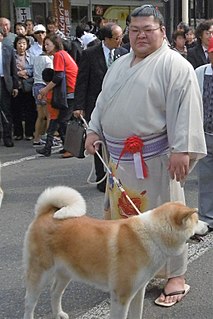
Takekaze Akira is a former professional sumo wrestler from Akita Prefecture, Japan. A former amateur sumo champion, he turned professional in 2002, reaching the top makuuchi division the following year. He was a runner-up in one tournament, earned two special prizes for Fighting Spirit, and one gold star for defeating a yokozuna. Takekaze is in first place for the slowest promotion from makuuchi debut to the third highest sekiwake rank in history. Aged 35 years and 2 months, he is in first place for the eldest to make his sekiwake debut post World War II. He was a member of Oguruma stable. He retired in January 2019 to become an elder of the Japan Sumo Association under the name Oshiogawa Oyakata.
The following are the events in professional sumo during 2006.
The following are the events in professional sumo during 2005.
The following are the events in professional sumo during 2004.
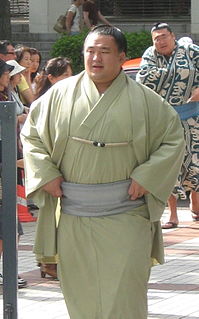
Tamawashi Ichirō is a professional sumo wrestler from Ulaanbaatar, Mongolia. He made his debut in January 2004 and reached the top makuuchi division in September 2008. His highest rank has been sekiwake. He has a makushita, a jūryō and a makuuchi division championship. He has two gold stars for defeating a yokozuna, and three special prizes. He wrestles for Kataonami stable. He has not missed a bout in his career to date and has the longest streak of consecutive matches among active wrestlers. In January 2019, he won his first top-division championship at the age of 34.
The following are the events in professional sumo during 2002.
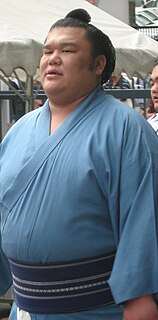
Kimurayama Mamoru is a former professional sumo wrestler from Wakayama Prefecture, Japan. His highest rank was maegashira 7. He is now a coach at Kasugano stable. He was the only wrestler in the elite ranks in his time from Wakayama Prefecture.

Kōbōyama Daizō is a former sumo wrestler from Tsukidate, Kurihara, Miyagi Prefecture, Japan. He made his professional debut in 1973 and reached the top makuuchi division in 1981. His highest rank was sekiwake. He earned two special prizes for Technique and was a runner-up in one tournament. He retired in 1990. He is now a sumo coach and ran the Takashima stable from 1993 until 2011. He was elected to the Japan Sumo Association's board of directors in 2018.
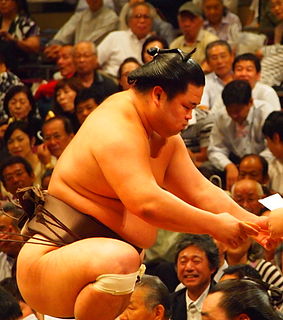
Myōgiryū Yasunari is a professional sumo wrestler from Takasago city in Hyōgo prefecture, Japan. Making his debut in May 2009 as a makushita tsukedashi out of university, he reached the top division for the first time in November 2011. His highest rank to date has been sekiwake. He has earned five special prizes for Technique.
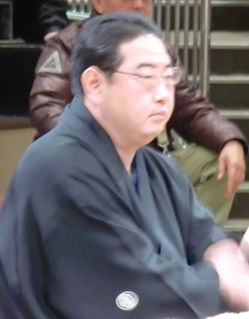
Oginohana Akikazu is a former sumo wrestler from Ichikawa, Chiba, Japan. He made his professional debut in July 1983, and reached the top division in January 1990. His highest rank was maegashira 2. He retired in July 1998. He is the son of former sekiwake Oginohana Masaaki and the elder brother of former komusubi Oginishiki. Since 2014 he has been the head of the Dewanoumi stable.
Dewanohana Yoshitaka is a former sumo wrestler from Nakasato, Aomori, Japan. He made his professional debut in July 1974, and reached the top division in November 1977. His highest rank was sekiwake. He retired in January 1988 and became an elder in the Japan Sumo Association under the name Dekiyama. Upon reaching the mandatory retirement age of 65 in May 2016 he was re-hired by the Sumo Association for five years as a consultant.

Kotoyūki Kazuyoshi is a sumo wrestler from Japan. He made his professional debut in 2008. After being a regular jūryō wrestler who made occasional trips to the top makuuchi division for a few years, through 2015 he has become a top division regular. He has one gold star for defeating a yokozuna and one special prize for Outstanding Performance. His highest rank to date is sekiwake. He wrestles for Sadogatake stable.



